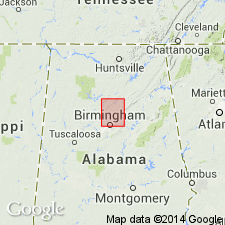
- Usage in publication:
-
- Ketona dolomite member*
- Modifications:
-
- Named
- Dominant lithology:
-
- Dolomite
- AAPG geologic province:
-
- Appalachian basin
Summary:
Name Ketona dolomite member of Knox dolomite introduced in this report for nearly pure dolomite 600 ft thick at base of Knox in north-central AL. Contains very little chert. Unit is thick-bedded, crystalline in texture, and light-gray in color. Age is Late Cambrian.
Source: GNU records (USGS DDS-6; Reston GNULEX).

- Usage in publication:
-
- Ketona dolomite*
- Modifications:
-
- Overview
- AAPG geologic province:
-
- Appalachian basin
Summary:
Later work by E.O. Ulrich resulted in discovery of beds in Knox dolomite of Alabama older than Ketona dolomite (to which older beds he applied the name Brierfield dolomite), also to subdivision of post-Ketona beds of Knox into (ascending) Bibb dolomite, Copper Ridge dolomite, and Chepultepec dolomite. The Ketona dolomite is therefore now [ca. 1936] treated as a formation, underlain by Brierfield dolomite and overlain by Bibb dolomite. (See Charles Butts, Alabama Geol. Survey Spec. Rpt., no. 14, 1926.)
Source: US geologic names lexicon (USGS Bull. 896, p. 1088).

- Usage in publication:
-
- Ketona dolomite
- Modifications:
-
- Overview
- AAPG geologic province:
-
- Appalachian basin
Summary:
Ketona dolomite is a coarsely crystalline light-gray thick-bedded dolomite 200 to 250 ft thick. Overlies Brierfield dolomite in Sixmile Creek. In western AL, overlies Blountia zone of Nolichucky and is 400 to 600 ft thick. Underlies Bibb dolomite.
Source: GNU records (USGS DDS-6; Reston GNULEX).

- Usage in publication:
-
- Ketona Dolomite
- Modifications:
-
- Overview
- AAPG geologic province:
-
- Appalachian basin
Summary:
Ketona Dolomite is present in the Valley and Ridge and the subsurface of the Appalachian Plateaus. Unit is light-gray coarsely crystalline thick-bedded, mostly chert-free, remarkably pure dolomite. Thickness ranges from 250 ft to 760 ft. Underlies Bibb Dolomite or Knox Group (undifferentiated). Overlies Conasauga Formation or Brierfield Dolomite. Age is Late Cambrian (Dresbachian and Franconian).
Source: GNU records (USGS DDS-6; Reston GNULEX).
For more information, please contact Nancy Stamm, Geologic Names Committee Secretary.
Asterisk (*) indicates published by U.S. Geological Survey authors.
"No current usage" (†) implies that a name has been abandoned or has fallen into disuse. Former usage and, if known, replacement name given in parentheses ( ).
Slash (/) indicates name conflicts with nomenclatural guidelines (CSN, 1933; ACSN, 1961, 1970; NACSN, 1983, 2005, 2021). May be explained within brackets ([ ]).

